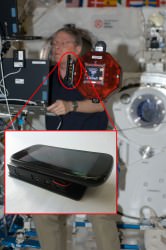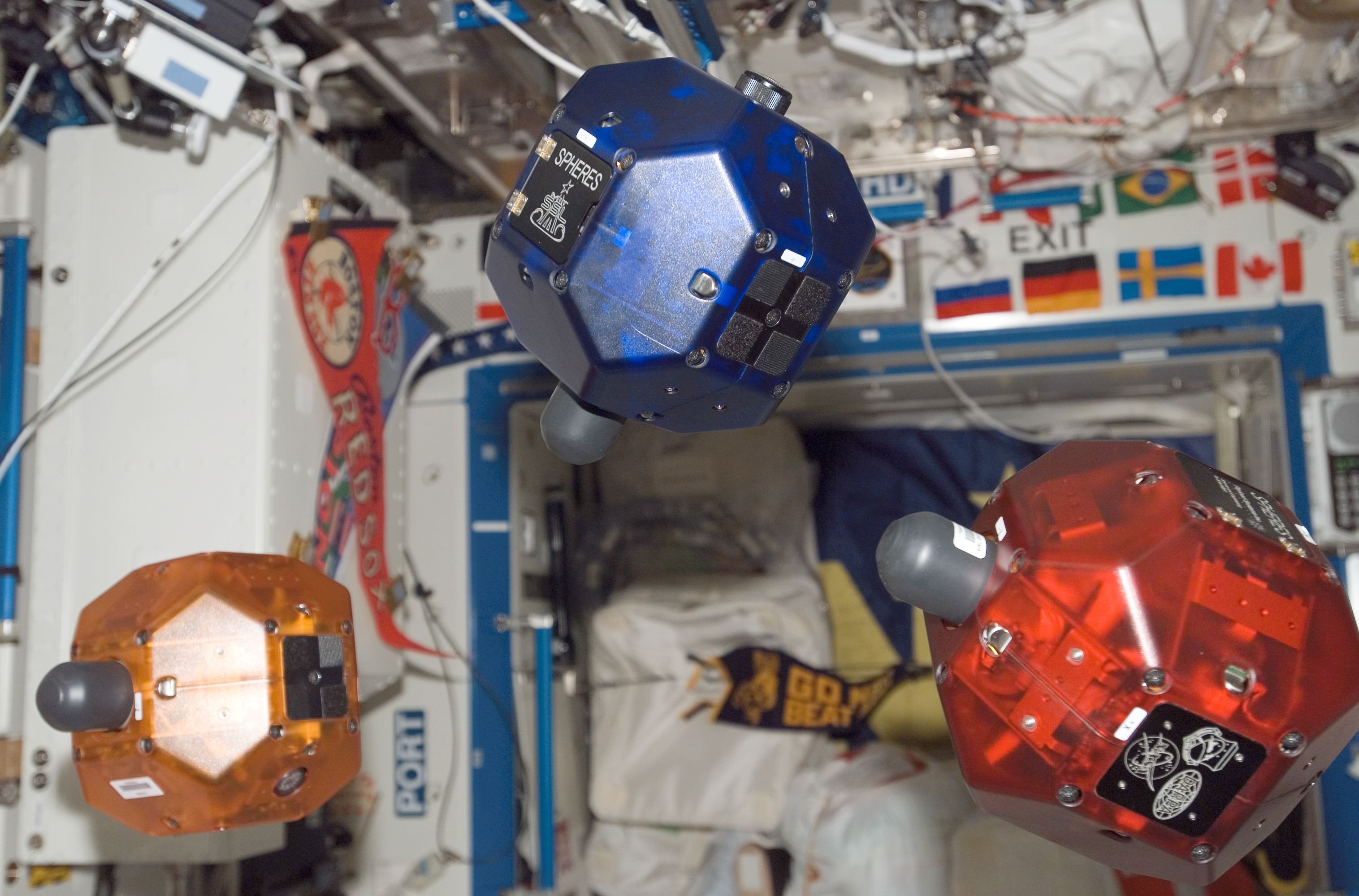[/caption]In an interesting case of science fiction becoming a reality, NASA has been testing their SPHERES project over the past few years. The SPHERES project (Synchronized Position Hold, Engage, Reorient, Experimental Satellites) involves spherical satellites about the size of a bowling ball. Used inside the International Space Station, the satellites are used to test autonomous rendezvous and docking maneuvers. Each individual satellite features its own power, propulsion, computers and navigational support systems.
The SPHERES project is the brainchild of David Miller (Massachusetts Institute of Technology). Miller was inspired by the floating remote “droid” that Luke Skywalker used to help hone his lightsaber skills in Star Wars. Since 2006, a set of five SPHERES satellites, built by Miller and his students have been onboard the International Space Station.
Since lightsabers are most likely prohibited onboard the ISS, what practical use have these “droids” been to space station crews?
The first SPHERES satellite was tested during Expedition 8 and Expedition 13, with a second unit delivered to the ISS by STS-121, and a third delivered by STS-116. The crew of ISS Expedition 14 tested a configuration using three of the SPHERES satellites. Since their arrival, over 25 experiments have been performed using SPHERES. Until recently, the tests used pre-programmed algorithms to perform specific functions.
“The space station is just the first step to using remotely controlled robots to support human exploration,” said Chris Moore, program executive in the Exploration Systems Mission Directorate at NASA Headquarters in Washington. “Building on our experience in controlling robots on station, one day we’ll be able to apply what we’ve learned and have humans and robots working together everywhere from Earth orbit, to the Moon, asteroids, and Mars.”

“Because the SPHERES were originally designed for a different purpose, they need some upgrades to become remotely operated robots,” said DW Wheeler, lead engineer in the Intelligent Robotics Group at Ames.
Wheeler added, “By connecting a smartphone, we can immediately make SPHERES more intelligent. With the smartphone, the SPHERES will have a built-in camera to take pictures and video, sensors to help conduct inspections, a powerful computing unit to make calculations, and a Wi-Fi connection that we will use to transfer data in real-time to the space station and mission control.”
In order to make the smartphones safer to use onboard the station, the cellular communications chips were removed, and the lithium-ion battery was replaced with AA alkaline batteries.
By testing the SPHERES satellites, NASA can demonstrate how the smart SPHERES can operate as remotely operated assistants for astronauts in space. NASA plans additional tests in which the compact assistants will perform interior station surveys and inspections, along with capturing images and video using the smartphone camera. Additional goals for the mission include the simulation of free-flight excursions, and possibly other, more challenging tasks.
“The tests that we are conducting with Smart SPHERES will help NASA make better use of robots as assistants to and versatile support for human explorers — in Earth orbit or on long missions to other worlds and new destinations,” said Terry Fong, project manager of the Human Exploration Telerobotics project and Director of the Intelligent Robotics Group at NASA’s Ames Research Center in Moffett Field, Calif.
You can view a video of the SPHERES satellites in action at: http://ti.arc.nasa.gov/m/groups/intelligent-robotics/smartspheres_test_2011-11-01-4x.avi (Sorry, no lightsaber action.).
If you’d like to learn more about NASA’s SPHERES program, visit: http://www.nasa.gov/mission_pages/station/research/experiments/SPHERES.html
Source: NASA Telerobotics News


nice use of tech there. talk about drop-in brains. software written for control and data acquisition could be ported and re-used for every performance increasing iteration of phones.
robust general purpose modules invade the universe and call home with pics.
That’s definitely one of the more compelling backronyms I’ve heard in recent times…. at leats it’s less contrived than MESSENGER! (MErcury Surface, Space ENvironment, GEochemistry and Ranging)
Perhaps this is how they came up with it?
“Right guys, we’ve got “Synchronized Position Hold”, we still need an ERE and an S, if were going to make SPHERES, any ideas?”
“How about ‘Engage?'”
“Yeah that’ll do. Next?”
“Energise?”
“Nah I don’t like that one,”
“Engage?”
“hmmm, I suppose so…. what about the R?”
“Reboost?”
“I like it, but it’s a bit “turbo-y”, what about Reorient?”
“Is that even a word? Never mind, stick it in”
and so on and so on…..
Press conference : “And we’re very pleased to announce the creation of our “Synchronized Position Hold, Engage, Reorient, Experimental Satellites”. Strangely enough the name can be constructed into the backronym SPHERES. What a coincidence!
Hmmmm…
Perhaps this is how they came up with it?
“Right guys, we’ve got “Synchronized Position Hold”, we still need an ERE and an S, if were going to make SPHERES, any ideas?”
“How about ‘Engage?'”
“Yeah that’ll do. Next?”
“Energise?”
“Nah I don’t like that one,”
“Engage?”
“hmmm, I suppose so…. what about the R?”
“Reboost?”
“I like it, but it’s a bit “turbo-y”, what about Reorient?”
“Is that even a word? Never mind, stick it in”
and so on and so on…..
Press conference : “And we’re very pleased to announce the creation of our “Synchronized Position Hold, Engage, Reorient, Experimental Satellites”. Strangely enough the name can be constructed into the backronym SPHERES. What a coincidence!
Hmmmm…
Perhaps this is how they came up with it?
“Right guys, we’ve got “Synchronized Position Hold”, we still need an ERE and an S, if were going to make SPHERES, any ideas?”
“How about ‘Engage?'”
“Yeah that’ll do. Next?”
“Energise?”
“Nah I don’t like that one,”
“Engage?”
“hmmm, I suppose so…. what about the R?”
“Reboost?”
“I like it, but it’s a bit “turbo-y”, what about Reorient?”
“Is that even a word? Never mind, stick it in”
and so on and so on…..
Press conference : “And we’re very pleased to announce the creation of our “Synchronized Position Hold, Engage, Reorient, Experimental Satellites”. Strangely enough the name can be constructed into the backronym SPHERES. What a coincidence!
Hmmmm…
Perhaps this is how they came up with it?
“Right guys, we’ve got “Synchronized Position Hold”, we still need an ERE and an S, if were going to make SPHERES, any ideas?”
“How about ‘Engage?'”
“Yeah that’ll do. Next?”
“Energise?”
“Nah I don’t like that one,”
“Engage?”
“hmmm, I suppose so…. what about the R?”
“Reboost?”
“I like it, but it’s a bit “turbo-y”, what about Reorient?”
“Is that even a word? Never mind, stick it in”
and so on and so on…..
Press conference : “And we’re very pleased to announce the creation of our “Synchronized Position Hold, Engage, Reorient, Experimental Satellites”. Strangely enough the name can be constructed into the backronym SPHERES. What a coincidence!
Hmmmm…
Wow, I don’t know about you guys but I got NOTHING out of that that the pictures didn’t already show. Totally non-informational with every generic generalization known to man. “over 25 experiments have been performed using SPHERES” uh huh, tell us about those…”Because the SPHERES were originally designed for a different purpose.” okay, tell us about that…”using remotely controlled robots to support human exploration.`Oh, how do they do that? “NASA can demonstrate how the smart SPHERES can operate as remotely operated assistants” Can they now? Because the Spheres now have smartphones I guess. But so does my kid but all he does with it is text “Fail” pictures to friends. They sure do sound neato but then, so does a beany cap with a propeller on it.